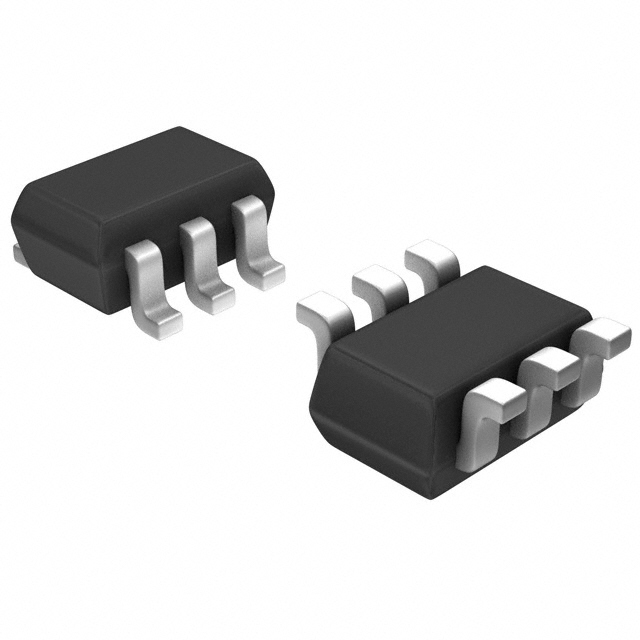Xem thông số kỹ thuật để biết chi tiết sản phẩm.

74LVC2G07DW-7
Product Overview
Category
The 74LVC2G07DW-7 belongs to the category of integrated circuits (ICs).
Use
This IC is commonly used as a dual buffer/driver with open-drain outputs.
Characteristics
- Dual buffer/driver with open-drain outputs
- High-speed operation
- Low power consumption
- Wide operating voltage range
- Schmitt-trigger action on all inputs
- ESD protection exceeds JESD 22
Package
The 74LVC2G07DW-7 is available in a small SOT363 package.
Essence
The essence of this product lies in its ability to provide high-speed buffering and driving capabilities with open-drain outputs.
Packaging/Quantity
The 74LVC2G07DW-7 is typically packaged in reels, with each reel containing a specific quantity of ICs. The exact quantity may vary depending on the manufacturer's specifications.
Specifications
- Supply voltage range: 1.65V to 5.5V
- Input voltage range: -0.5V to VCC + 0.5V
- Output voltage range: 0V to VCC
- Maximum output current: ±32mA
- Operating temperature range: -40°C to +125°C
Detailed Pin Configuration
The 74LVC2G07DW-7 has the following pin configuration:
___________
Y1 | 1 6 | VCC
Y2 | 2 5 | A
GND | 3 4 | B
‾‾‾‾‾‾‾‾‾‾‾
Functional Features
- Dual buffer/driver: The 74LVC2G07DW-7 can buffer and drive signals from two different sources simultaneously.
- Open-drain outputs: The open-drain outputs allow for easy interfacing with other devices, as they can be connected to a common bus or pull-up resistors.
- High-speed operation: This IC is designed to operate at high speeds, making it suitable for applications that require fast signal transmission.
- Low power consumption: The 74LVC2G07DW-7 is designed to minimize power consumption, making it ideal for battery-powered devices.
- Schmitt-trigger action: All inputs of this IC feature Schmitt-trigger action, ensuring reliable and noise-immune operation.
- ESD protection: The ESD protection of the 74LVC2G07DW-7 exceeds JESD 22 standards, providing robustness against electrostatic discharge.
Advantages and Disadvantages
Advantages
- High-speed operation enables fast signal transmission.
- Low power consumption prolongs battery life in portable devices.
- Wide operating voltage range allows for compatibility with various systems.
- Schmitt-trigger action ensures reliable operation even in noisy environments.
- ESD protection provides added durability against electrostatic discharge.
Disadvantages
- Limited number of buffer/driver channels (dual-channel).
Working Principles
The 74LVC2G07DW-7 operates by receiving input signals on pins A and B. It buffers and drives these signals through its open-drain outputs, Y1 and Y2. The Schmitt-trigger action on the inputs helps maintain signal integrity by reducing the effects of noise. The IC's low power consumption and wide operating voltage range make it suitable for a variety of applications.
Detailed Application Field Plans
The 74LVC2G07DW-7 finds applications in various fields, including but not limited to: - Communication systems - Industrial automation - Consumer electronics - Automotive electronics - Medical devices
Detailed and Complete Alternative Models
Some alternative models that offer similar functionality to the 74LVC2G07DW-7 include: - SN74LVC2G07 from Texas Instruments - MC74VHC2G07 from ON Semiconductor - NCV8402 from ON Semiconductor - TC7SZ07FU from Toshiba
These alternative models can be considered based on specific requirements and availability.
Word count: 440 words
Liệt kê 10 câu hỏi và câu trả lời thường gặp liên quan đến ứng dụng 74LVC2G07DW-7 trong giải pháp kỹ thuật
Sure! Here are 10 common questions and answers related to the application of 74LVC2G07DW-7 in technical solutions:
Q: What is the 74LVC2G07DW-7? A: The 74LVC2G07DW-7 is a dual buffer/driver IC (Integrated Circuit) with open-drain outputs, commonly used for level shifting and signal buffering.
Q: What voltage levels can the 74LVC2G07DW-7 handle? A: The 74LVC2G07DW-7 can handle voltage levels from 1.65V to 5.5V, making it compatible with a wide range of digital systems.
Q: How many channels does the 74LVC2G07DW-7 have? A: The 74LVC2G07DW-7 has two independent channels, allowing it to buffer or drive two separate signals simultaneously.
Q: Can the 74LVC2G07DW-7 be used for bidirectional communication? A: No, the 74LVC2G07DW-7 is a unidirectional buffer/driver and cannot be used for bidirectional communication. For bidirectional applications, a different IC should be used.
Q: What is the maximum output current of the 74LVC2G07DW-7? A: The 74LVC2G07DW-7 can source/sink up to 32mA of current per channel, making it suitable for driving moderate loads.
Q: Does the 74LVC2G07DW-7 require external pull-up resistors? A: Yes, the 74LVC2G07DW-7 requires external pull-up resistors to provide a logic high level when the output is in the high-impedance state.
Q: Can the 74LVC2G07DW-7 tolerate overvoltage on its inputs? A: No, the 74LVC2G07DW-7 is not designed to tolerate overvoltage on its inputs. Proper voltage level translation should be implemented if interfacing with higher voltage systems.
Q: What is the typical propagation delay of the 74LVC2G07DW-7? A: The typical propagation delay of the 74LVC2G07DW-7 is around 4.5ns, making it suitable for high-speed applications.
Q: Can the 74LVC2G07DW-7 be used in automotive applications? A: Yes, the 74LVC2G07DW-7 is qualified for automotive applications and can operate within the specified temperature range (-40°C to +125°C).
Q: Are there any recommended decoupling capacitors for the 74LVC2G07DW-7? A: Yes, it is recommended to place a 100nF decoupling capacitor near the power supply pins of the 74LVC2G07DW-7 to ensure stable operation and minimize noise.
Please note that these answers are general and may vary depending on the specific application and requirements. It is always recommended to refer to the datasheet and consult the manufacturer for detailed information.

